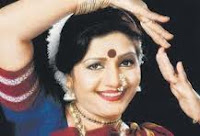Tamasha Folk Theatre of Maharashtra




Tamasha is a traditional Marathi folk art form. It includes both singing and dancing forms. It is widely performed theatre groups within the state of Maharashtra, India. It is in fact a mobile theatre that goes to different regions of Maharashtra. The word ‘Tamasha’ is Persian origin meaning ‘to have fun or to play’. Today, this word is commonly used in Hindi, Marathi, Kannada and Urdu. Again, some have researched the origin of the word Tamasha to Turkish langaugeand has entered into urdu and finally borrowed from Urdu to Marathi.
In Marathi the word Tamasha means 'A mixtures of specialized performances like dance, music, different enactements or roles by women or girls, participation of women, and singing lavanis'. I wonder how Persian or Turkish languages have influence Marathi.
This folk art from is so very deep rooted in rural Maharashtra for more than eight-nine centuries that it is quite difficult to say when this Tamasha was first staged. This art form is called as Lok Natya of Maharashtra, wherein, in rural they still call it as Tamasha. This art from has influence of other art forms like ghazals, kirtan, kathak dance and so on.There are two types of Tamasha: dholki bhaari and the older form, Sangeet baari which contains more dance and music than drama.
History reveals that this art form perhaps existed or came to be known during reigh of Adil Shahi and this art from from was also konwn as Tamashagir and writers of these form are known as Shahirs. Again, influence of Urdu langauge is high in Tamasha. However, 'Gammath' a part of Tamasha had become popular among Muslim rulers. A reference of the same is made by Sant Gyaneshwar in Thirteenth Century (1290 AD)in his literature.
This art form was performed by low caste community and also watched mostly by them. It is also said that, High and Upper caste people seldom viewed this art form and viewing Tamasha was considered as committing sin. Even the instruments used like Dhol or Dolki and Tuntune were not used by upper caste. In the sense, upper caste did not learn to play these instruments. If a upper caste individual wanted learn these instruments were not allowed to learn. Like playing of ‘Nadaswaram’ was strictly restricted to Barber community in South India-especially Tamil Nadu.
The children of Maher and Mang communities are trained in this art and they give the performance during festival days. Initially it was males and boys performing it. Slowly, it has been replaced by females. On other days also they give performance as earning for livelihood. Though it is women dominated art form, one also finds male artist on the stage.
Women are dressed in traditional saree in bright red or green worn in Maharashtrian style called 'Kachi', hair tied like a juda with flowers covering it, wearing lots of bangles and tying ghoongaroos (heavy anklets)performers this art. Maharashtrian NOSE PIN called NATH is an important ornamnets worn by the women. Men also wear dhothi, kurtha, traditional caps and play instruments.
In Maharashtra, every village has the village diety ritual celebration and during these celebrations, tamasha is organized for the community at large.
Today the performance of Tamasha has incorporated modern text, prose, music, sound system and the traditional Sardar has totally disappeared. Again, both Tamasha has influenced Cinema and vice versa.
It is again said that the legendary tamasha artiste Vithabai who was performing on stage on public demand, developed labour pain during the perfromance and also continued her performance after delivering her baby. (Tamasha was stopped for brief period and she delived her baby behind the stage and resumed back).
Ban on Tamasha:
Again, there was aban on this art from during the chief Ministership of Sri Kher on compalints that much of vulgarity is being used in Tamasha. Due to this ban imposed, many Tamasha phads and Kalavanth-artists became distress and had no other means of earnings. This led to severe struggle for livelihood of the artists and their families. Many eminent persons from the society like Sri Obasahib Majumdar, Sri Bapusahib Jitinkar, Sri Popatlal Saha and others, looking into the conditions of these artists made an appeal to the government of Maharashtra in lifting the imposed ban on Tamasha.
After the lifting the ban the artists formed Tamasha Sudhar Smithi and framed rules and regulation for performing Tamasha.
1.As this art being women dominated one, the first rule framed was that the main artists or the performer will not sit in front of the gate and make publicity.
2.Songs composed shall not be in a Vulgar language with double meaning.
3. Dialogue also shall not be in vulgar language with double meaning.
4. Main imposition on audience that they will not touch the performer during the performance.
5. These performers and the performance is respected by all including the performers and the audience and audience shall not force or blackmail or exploit the women performers.
Though, the rules were framed for safeguarding the art from, but the performers did face lots of difficulties in performing as the audience demanded use of vulgar language.
Somewhere in 1953-55, this art form was sent to the ministry of culture for gaining recognition under folk theatre and also these Vyag Natyas are the performance script and composition were sent to Censor Board for Scrutinization.
After, this there has been a significant changes in the performance of this art form.


Comments
Regards
Sphoorthi Theatre
maratha